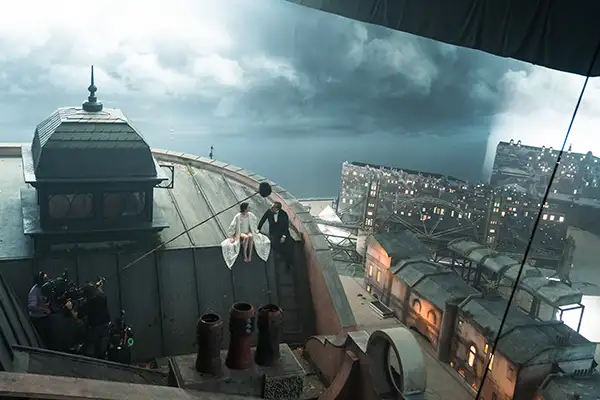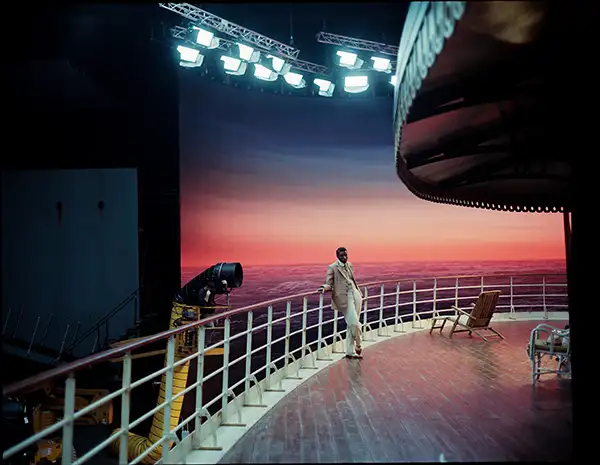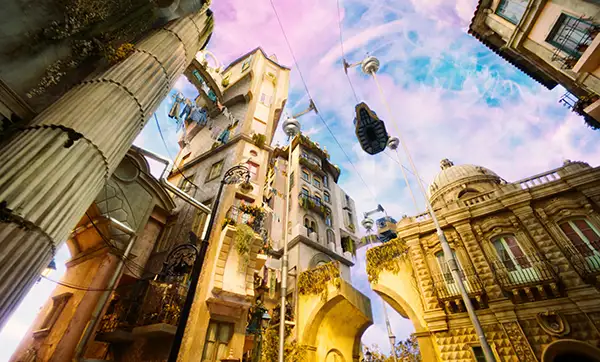In this interview, Poor Things cinematographer Robbie Ryan tells us about shooting with ektachrome and LED lights, the worlds in the film, and more.
Yorgos Lanthimos’ Poor Things, shot by cinematographer Robbie Ryan, is quite simply a fantastic film. Adapted from Alasdair Gray’s 2014 novel of the same name, it tells the story of a young woman named Bella Baxter (Emma Stone), who was brought back to life by scientist Godwin ‘God’ Baxter (Willem Dafoe), when he found a dead pregnant woman and implanted her newborn baby’s brain into her body. And Bella is a different kind of creature entirely: both a child who can’t wait to discover the world, and an adult who hasn’t been corrupted by gender preconceptions.
Throughout the movie, we follow Bella as she escapes from her good-natured fiancé, Max McCandles (Ramy Youssef), and embarks on a journey of liberation with debauched lawyer Duncan Wedderburn (Mark Ruffalo), who soon learns he can’t control her. But Bella’s adventure continues, first in Lisbon and then in Paris, and the more she learns about the world around her, the more colourful it becomes. Eventually, Bella finds a way to belong to this world while staying true to herself, in a film that’s as daring, hilarious and unpredictable as it is dense with themes.
But an aspect of the film that immediately stands out is how incredibly well-shot and huge in scope it is. Poor Things gives us the asymmetrical, surreal Yorgos Lanthimos look we love, and combines it with detailed, stunning set design and cinematography. If Godwin’s world is in black and white, with oversized objects and hybrid pets reminding us of a dark fairytale, Bella’s journey is filled with colours, from the pastel skies of Lisbon to the wonderfully eccentric places she visits in Paris. It’s a highly immersive atmosphere that will have you marvel at the screen with a sense of childlike wonder, and learning how those sets were created and the film was shot has us even more impressed. We spoke with cinematographer Robbie Ryan about shooting Poor Things with ektachrome film stock and LED lights, the world building in the movie, his inspirations, and more!
Robbie Ryan on Poor Things’ Success and Working with Yorgos Lanthimos
Congratulations for this incredible film! I saw it in Venice and I was blown away by it. When you were making it, did you know that it was going to be received so well?
Robbie Ryan: No, not at all! Right up until the premiere, I don’t think we fully knew what people were gonna make of it. When we were filming it, every day was like a crazy sort of challenge, but we all loved it. It’s still early, but the film has been received so warmly: it’s really a pleasure to see people connecting with it and understanding it. And basically enjoying it, and having a laugh! Cinema should be a place where we can have a laugh, you know? [smiles]
People were laughing from start to end at the press screening! It was amazing!
R. R.: I’ve only seen it once in an audience, and that was the premiere in Venice: it was a public screening, and they were not so sure about when to laugh or not. But I did hear the press conference was a really funny one, where everybody was laughing a lot. I look forward to seeing it in a in a cinema with a crowd, and hearing a few laughs.
This is your second collaboration with Yorgos Lanthimos… Of many! You’ve already shot another one, haven’t you?
R. R.: I’ve done three films with him now. Poor Things was the second one, and then we did one last year [Kind of Kindness] that’s going to come out next year!
Can’t wait for that one!
R. R.: [laughs] That was pretty fun to do! Yorgos makes very interesting films.

What drew you to Poor Things in particular, and how different of a collaboration was it, compared to The Favourite?
R.R.: You know, after The Favourite, this one was a departure for Yorgos when it came to how to create a world. Before Poor Things, both Yorgos and myself had done most of our films in natural light and at real locations. With this, he wanted to go on a different direction create an unreal world. That, in itself, is a huge challenge.
From a visual aspect, we approached the film the same way, but from every other aspect – the production design, the sound, the costumes… – it was totally different, a big push for him. It was good to have done The Favourite, because I knew how he liked to move the camera, and the use of different lenses. It was definitely a benefit, as we shot it similarly, really.
Robbie Ryan on World Building in Poor Things
I read that you shot the entire film in a studio.
Robbie Ryan: Yes, the London streets were exterior, but the rest of it was all inside a studio in Hungary. And design on the film is phenomenal, you know. They [production designers James Price and Shona Heath] had such a creative blowout: it was a joy to watch.
How was the actual set made? Did you get to see what it would all look like beforehand?
R. R.: We would go in every couple of days. The art department had this computer program called Unreal Engine [a real-time 3D creation tool for immersive experiences], where you create the set, and you walk all the way around it. You can see it all in a three-dimensional computer space. And then Yorgos would say, “maybe move that corridor there a bit.” Or, you know, “let’s build this doorway here”. There were lots of things he was able to do in the 3D creative world.
Then he’d say, “Okay, that’s good,” and they would all go away and build it. You had been looking at it on a computer for so long, and a couple of weeks later you’re walking in and, Oh, my God! This is exactly what it looked like on the computer. But it’s in a real space. It was mind-blowing for me! Like going into a theme park.
That’s what it feels like for a viewer too!
R. R.: It’s just unfortunate that it can only last for a short period of time, because it gets destroyed: another film has to go in there. That was kind of heartbreaking, you know? You kind of go, “Oh, Paris is gone.”
And it’s not just one world, but there’s five of them!
R. R.: Yeah. I was there for a long time on the preparation, and I saw the London set get built up from scratch, up till Baxter’s house, and then, while we were filming other scenes, I saw it getting destroyed. [sighs and smiles] They did their best to break it down and recycle it, so it wasn’t all destroyed. But there’s an awful lot of destruction as well! [laughs]
It kind of mirrors the film’s themes, in a way!
R. R.: That’s true!
The Challenges of Filming with Ektachrome Stock and LED Screens
So how did you manage to make it look so realistic? I’m thinking of the scenes on the boat, for example: it definitely doesn’t look like a studio!
Robbie Ryan: Yorgos was keen to try out this old film stock that’s been reissued, called ektachrome. It’s a very colorful and very contrasty film stock, and he thought it could suit the world on the boat. We had a LED wall which created the sea and the sky. A lot of people, these days, film in a set, and there’s a green screen, so you kind of imagine what might be there. But when we were filming Poor Things, you could see the the sky for what it really was: it really helped the actors and everybody involved feel like they were on a boat. The colorful ektachrome stock enhanced that even more: it was joy to work with that, and a challenge as well.

What was the most challenging aspect of it?
R. R.: These LED screens are very bright, but because the film stock was very slow, it needed a lot of lights. So I’d have all these lights up in the ceiling, and their lights would then kind of spill over into the LED screen, and it wouldn’t be as vivid. It would almost have been better if there had been a green screen! I had never really done anything like that, so I wasn’t very clever with how best to get the lighting the right balance, and… I kind of got it right by the end! [laughs] So I learned how to do it the wrong way around.
Can you talk about the Lisbon set?
R. R.: Lisbon was the biggest set we built! There were two quadrants: a harbour section where she eats the custard pies, and another section where the hotel was. There were a lot of buildings in there, and we had to create a feeling of natural light: you know, if that was a real space, you’d have like a sky above it. So we built the sky in the studio. And then, obviously, because it’s Lisbon, you have the sunlight all the time. So that meant, not only did I need to have a sky, but I had to incorporate loads of big lights to try and make it feel sunny. So… It just got out of control, that place! [laughs] It was probably the most challenging set of the film for a lot of us.
Luckily, the story is quite fun in that one. She’s discovering sex for the first time, and she’s in a hotel bedroom… We’re kind of hidden by the story being so funny in that part, and the humour ramps up to a really great level in Lisbon, I think.
Godwin Baxter’s “Black and White World”
The funniest parts of the film for me were Willem Dafoe’s burp bubbles!
Robbie Ryan: Willem Dafoe knows how to open his mouth very big, I could say that much! He almost dislodged his jaw! We were all like, “How does he do that?” [laughs] He’s got massive mouth! But that’s the character, Godwin Baxter. He’s written as a character who has this huge mouth. But I know what you mean: I’m just laughing, thinking about it, you know? Deadpan humour is one of my favourite types of humour.
I love that those first scenes are in black and white.
R. R.: Yorgos didn’t originally think it was going to be all black and white at the start. But then he decided, very close to when we started filming, that he would make those first 20-30 min in black and white, so that, when [Bella] goes on her journey, all of a sudden there’s a flourish of colour. It really helps explain that feeling of “Wow, here’s the world!”. Then, she comes back to that black and white world, and she brings the color back after her journey.
I really felt for Bella and Godwin. It’s a special sort of father-daughter relationship they have, and I feel that the black and white helps with that too.
R. R.: The chemistry between Willem and Emma is so strong, and I think it really comes across. They had such fun working together! And Rami [Youssef], who plays McCandles, is also a really fun person. When we filmed Poor Things, we shot all the English stuff first. So we’re in Baxter’s house, and it begins there, but it also ends there. The three of them had this beautiful world to themselves for the first three or four weeks of the filming process. Then, as a film crew, we all moved to another stage, and we all went to Lisbon. It was a whole new dynamic, because Bella was with Mark Ruffalo, who plays Duncan Wedderburn, and we were all out in this crazy Lisbon set! We missed all of that great fun in Godwin’s place, and the safety of that.
Robbie Ryan on Visual Inspirations for Poor Things and Recent DP Work he Admires
What were your biggest inspirations for Poor Things, visually?
Robbie Ryan: Yorgos is keen on Francis Ford Coppola’s Dracula: he really enjoyed the “fakeness” of that film, but it had kind of a beautiful characteristic to it, because it was all filmed in film sets as well. He was like, “Well, that works. Why don’t we try that?” Because it doesn’t look totally real, but it totally works for the story. Our story was kind of similar, and I think Yorgos interpreted that into his own world very well.

Would you work with virtual reality?
R. R.: I certainly wouldn’t say no to it. You know, we used a little bit of virtual reality in Poor Things, where you have that LED backdrop.
It feels so immersive!
I was in Venice’s VR island last year, and I really enjoyed being a participant in it. I can see the potential. In terms of filming it, I’m not sure if I’d enjoy it so much, because there’s so much technicality in it. I’m very basic when it comes to technical stuff: I like simplicity. So I might not be the right technician, for that kind of thing!
Are there any DPs whose work impressed you recently?
R. R.: Oh, interesting! Well, from a DP’s point of view, I’m a big fan of a cinematographer called Christopher Blauville, who did Meek’s Cutoff. That’s one of my favourite films, but that was nearly 12 years ago! He still makes really nice stuff: he’s got a great aesthetic.
There are tons of great cinematographers out there! This year, I loved a film called Godland, from director Hlynur Pálmason: it’s beautiful looking and really evocative. Hélène Louvart shot Alice Rohrwacher’s La Chimera: it’s my favourite of the year! It’s shot so beautifully. Alice Rohrwacher is a great filmmaker, and Hélène is an amazing cinematographer.
Thank you for talking to us!
This interview was edited for length and clarity.
Watch both Poor Things and Kinds of Kindness on digital and on demand.

